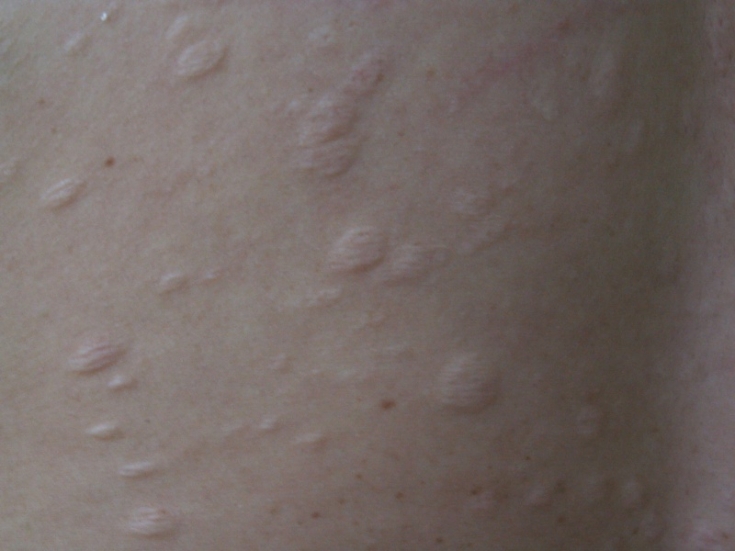Dermatological diseases at the moment there are quite a large number. Some of them are found almost every day in the practice of dermatologists, and some are very rare. However, a real professional is simply obliged to have enough information about even the rarest dermatological diseases in order to diagnose and start treating the pathology in a timely manner. The outcome of the disease often depends on how quickly therapy is started. Today on estet-portal.com read about the causes, development mechanisms and characteristic symptoms of such a rare dermatological pathology as anetoderma.
Causes and characteristic symptoms of anetoderma
Anetodermia or patchy skin atrophy – it is a rare dermatosis of a non-inflammatory nature. Its name comes from the Greek word anetos, which means "loose", "empty".
The disease is characterized by the destruction of elastin fibers in the skin, resulting in atrophied areas appearing on it.
At the same time, the clinical picture may differ depending on which of the three forms of pathology is observed in the patient. It is important to note that in the later stages the disease is very difficult to treat, and the pathological process is almost irreversible, which is why it is so important to detect and start treatment of anetoderma in a timely manner.
Anetoderma:
- main causes of primary and secondary anetoderma;
- pathogenetic mechanisms of development of various forms of anetoderma;
- clinical picture of anetoderma: symptoms, depending on the form of the disease.
Main causes of primary and secondary anetoderma
Anetoderma – it is a pathology of the skin, which can be primary, that is, congenital, as well as secondary or acquired. The etiology of primary anetoderma has not yet been fully elucidated. It is assumed that the disease may develop as a result of:
- genetic predisposition of the organism;
- presence of chronic infectious diseases;
- pathology of the endocrine glands responsible for metabolism in the body;
- pathologies of the immune system.
Secondary anetoderma develops after previous inflammatory skin diseases, such as acne, herpes, chicken pox, molluscum contagiosum, sarcoidosis, skin tuberculosis, oncopathology, systemic lupus erythematosus and others.
Pathogenetic mechanisms of development of various forms of anetoderma
The pathogenesis of anetoderma, as well as the etiology of the disease, is not fully understood. However, today it is believed that the loss of elastin fibers occurs as a result of the following mechanisms:
- genetically programmed defect in the formation or structure of elastin fibers;
- excessive synthesis of matrix metalloproteinases that destroy elastin fibers;
- lack of inhibitors that inhibit elastase activity;
- degradation of elastin as a result of local circulatory disorders provoked by the formation of microthrombi in the vessels;
- the presence of common areas in the molecules of elastin and phospholipids.
All these pathogenetic mechanisms, as a result, can lead to the destruction of elastin fibers and the occurrence of anetoderma.

Clinical picture of anetoderma: symptoms, depending on the form of the disease
The clinical picture of anetoderma depends on which form of the disease is observed in the patient. There are three types of pathological process:
- Erythematous anetoderma or Yadasson's anetoderma is characterized by damage to the skin of the trunk, face and extremities. Spots appear on the skin from 5 to 20 mm in diameter with a thin, wrinkled surface, initially pale pink, and then bluish or whitish in color. The foci can be multiple or single, their appearance is not accompanied by itching, soreness or other unpleasant sensations. A characteristic symptom – sunken fossa when pressing on the surface of the spots;
- Tumor-like anetoderma or Schwenninger-Buzzi anetoderma is characterized by the formation of lesions on the arms or back. In this case, the rashes look like small tumors, and protrude above the surface of the skin. They may show a network of dilated blood vessels;
- urticaria anetoderma or anetoderma Pellizzari – a rare form of the disease, which is characterized by the appearance of a rash resembling that of urticaria. In the future, areas of the skin at the site of the rash atrophy. A distinctive feature is the same symptom of a sinking fossa when pressed.
An important feature of anetoderma – it is the possibility of all three forms of the lesion occurring simultaneously in the same patient.
However, the methods of diagnosis and treatment for all forms of the disease are the same. More about them – read the next article. Thank you for staying with estet-portal.com. Read more interesting articles on the site in the "Dermatology" section.
You may also be interested in: "Elastin protein: why our skin needs it and how to make up for its deficiency".







Add a comment